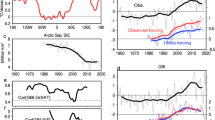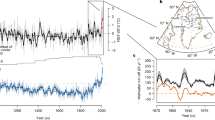Abstract
A central issue in climate dynamics is to understand how the Northern and Southern hemispheres are coupled during climate events. The strongest of the fast temperature changes observed in Greenland (so-called Dansgaard–Oeschger events) during the last glaciation have an analogue in the temperature record from Antarctica. A comparison of the global atmospheric concentration of methane as recorded in ice cores from Antarctica and Greenland permits a determination of the phase relationship (in leads or lags) of these temperature variations. Greenland warming events around 36 and 45 kyr before present lag their Antarctic counterpart by more than 1 kyr. On average, Antarctic climate change leads that of Greenland by 1–2.5 kyr over the period 47–23 kyr before present.
This is a preview of subscription content, access via your institution
Access options
Subscribe to this journal
Receive 51 print issues and online access
$199.00 per year
only $3.90 per issue
Buy this article
- Purchase on Springer Link
- Instant access to full article PDF
Prices may be subject to local taxes which are calculated during checkout


Similar content being viewed by others
References
Dansgaard, W.et al. Evidence for general instability of past climate from a 250-kyr ice-core record. Nature 364, 218– 220 (1993).
Grootes, P. M., Stuiver, M., White, J. W. C., Johnsen, S. & Jouzel, J. Comparison of oxygen isotope records from the GISP2 and GRIP Greenland ice cores. Nature 366, 552–554 (1993).
Oeschger, H.et al. in Climate Processes and Climate Sensitivity(eds Hansen, J. E. & Takahashi, T.) 299–306 (Vol. 29, Geophys. Monogr. Ser., Am. Geophys. Union, Washington DC, (1984)).
Johnsen, S., Dahl-Jensen, D., Dansgaard, W. & Gundestrup, N. Greenland palaeotemperatures derived from GRIP bore hole temperature and ice core isotope profiles. Tellus B 47, 624– 629 (1995).
Schwander, J.et al. Age scale of the air in the summit ice: Implication for glacial–interglacial temperature change. J. Geophys. Res. 102, 19483–19494 (1997).
Bond, G.et al. Correlations between climate records from North Atlantic sediments and Greenland ice. Nature 365, 143–147 (1993).
Roemmich, D. Estimation of meridional heat flux in the North Atlantic by inverse methods. J. Phys. Oceanogr. 10, 1972– 1983 (1981).
Broecker, W. S. & Denton, G. H. The role of ocean–atmosphere reorganizations in glacial cycles. Geochim. Cosmochim. Acta 53, 2465–2501 (1989).
Charles, C. D., Lynch-Stieglitz, J., Ninnemann, U. S. & Fairbanks, R. G. Climate connections between the hemisphere revealed by deep sea sediment core/ice core correlations. Earth Planet. Sci. Lett. 142, 19–27 (1996).
Behl, R. J. & Kennett, J. P. Brief interstadial events in the Santa Barbara basin, NE Pacific, during the past 60 kyr. Nature 379, 243–379 ( 1996).
Bard, E., Rostek, F. & Sonzogni, C. Interhemispheric synchrony of the last deglaciation inferred from alkenone palaeothermometry. Nature 385 , 707–710 (1997).
Grimm, E. C., Jacobson, G. L. J, Watts, W. A., Hansen, B. C. S. & Maasch, K. A. A50,000-year record of climate oscillations from Florida and its temporal correlation with the Heinrich events. Science 261, 198– 200 (1993).
Benson, L. V.et al. Climatic and hydrologic oscillations in the Owens Lake basin and adjacent Sierra Nevada, California. Science 274 , 746–749 (1996).
Chappellaz, J.et al . Synchronous changes in atmospheric CH4and Greenland climate between 40 and 8 kyr BP. Nature 366, 443–445 ( 1993).
Johnsen, S. J., Dansgaard, W., Clausen, H. B. & Langway, C. C. Oxygen isotope profiles through the Antarctic and Greenland ice sheets. Nature 235, 429–434 ( 1972).
Jouzel, J.et al. Vostok ice core: A continuous isotope temperature record over the last climatic cycle (160,000 years). Nature 329 , 403–408 (1987).
Bender, M.et al. Climate correlations between Greenland and Antarctica during the past 100,000 years. Nature 372, 663– 666 (1994).
Stocker, T. F., Wright, D. G. & Mysak, L. A. Azonally averaged, coupled ocean–atmosphere model for paleoclimate studies. J. Clim. 5, 773–797 (1992).
Blunier, T.et al. Timing of the Antarctic Cold Reversal and the atmospheric CO 2increase with respect to the Younger Dryas event. Geophys. Res. Lett. 24, 2683–2686 (1997).
Hammer, C. U.et al. Report on the Stratigraphic Dating of the GRIP Ice Core(Spec. Rep. of the Geophysical Dept, Niels Bohr Institute for Astronomy, Physics and Geophysics, Univ. Copenhagen, in the press).
Johnsen, S. J.et al . Irregular glacial interstadials recorded in a new Greenland ice core. Nature 359, 311– 313 (1992).
Crowley, T. J. North Atlantic deep water cools the Southern Hemisphere. Paleoceanography 7, 489–497 ( 1992).
Stocker, T. F. & Wright, D. G. Rapid changes in ocean circulation and atmospheric radiocarbon. Paleoceanography 11, 773–796 ( 1996).
Schiller, A., Mikolajewicz, U. & Voss, R. The stability of the thermohaline circulation in a coupled ocean–atmosphere general circulation model. Clim. Dyn. 13, 325–348 (1997).
Dahl-Jensen, D., Johnsen, S. J., Hammer, C. U., Clausen, H. B. & Jouzel, J. in Ice in the Climate System(ed. Peltier, W. R.) 517–532 (Springer, Berlin, ((1993)).
Johnsen, S. J., Dansgaard, W. & White, J. W. C. The origin of Arctic precipitation under present and glacial conditions. Tellus B 41, 452 –468 (1989).
Severinghaus, J. P., Sowers, T., Brook, E. J., Alley, R. B. & Bender, M. L. Timing of abrupt climate change at the end of the Younger Dryas interval from thermally fractionated gases in polar ice. Nature 391, 141–146 ( 1998).
Blunier, T., Chappellaz, J., Schwander, J., Stauffer, B. & Raynaud, D. Variations in atmospheric methane concentration during the Holocene epoch. Nature 374 , 46–49 (1995).
Robin, G. deQ. in The Climatic Record in Polar Ice Sheets(ed. Robin, G. de Q.) 180 –184 (Cambridge Univ. Press, London, ( 1983)).
Salamatin, A. N.et al . Ice core age dating and paleothermometer calibration based on isotope and temperature profiles from deep boreholes at Vostok Station (East Antarctica). J. Geophys. Res. 103, 8963–8978 (1998.)
Yiou, F.et al. Beryllium 10 in the Greenland Ice Core Project ice core at Summit, Greenland. J. Geophys. Res. 102, 26783– 26794 (1997).
Beer, J.et al. The Last Deglaciation: Absolute and Radiocarbon Chronologies(eds Bard, E. & Broecker, W. S.) 141–153 (NATO ASI Ser. I 2, Springer, Berlin, (1992)).
Raisbeck, G. M.et al . in The Last Deglaciation: Absolute and Radiocarbon Chronologies (eds Bard, E. & Broecker, W. S.) 127–140 (NATO ASI Ser. I 2, Springer, Berlin, (1992)).
Jouzel, J.et al. The two-step shape and timing of the last deglaciation in Antarctica. Clim. Dyn. 11, 151–161 (1995).
Sowers, T. & Bender, M. Climate records covering the last deglaciation. Science 269, 210– 214 (1995).
Siegenthaler, U., Eicher, U., Oeschger, H. & Dansgaard, W. Lake sediments as continental δ18O records from the transition of glacial–interglacial. Ann. Glaciol. 5, 149–152 (1984).
Bond, G. C. & Lotti, R. Iceberg discharges into the North Atlantic on millennial time scales during the last deglaciation. Science 267, 1005–1010 ( 1995).
Stocker, T. F. & Wright, D. G. The effect of a succession of ocean ventilation changes on radiocarbon. Radiocarbon 40, 359–366 ( 1998).
Stocker, T. F. & Wright, D. G. Rapid transitions of the ocean's deep circulation induced by changes in surface water fluxes. Nature 351, 729–732 (1991).
Wright, D. G. & Stocker, T. F. in Ice in the Climate System(ed. Peltier, W. R.) 395–416 (NATO ASI Ser. I 12, Springer, Berlin, (1993)).
MacAyeal, D. R. Alow-order model of the Heinrich event cycle. Paleoceanography 8, 767–773 ( 1993).
MacAyeal, D. R. Binge/purge oscillations of the Laurentide ice sheet as a cause of the North Atlantic's Heinrich events. Paleoceanography 8, 775–784 (1993).
Stocker, T. F., Wright, D. G. & Broecker, W. S. The influence of high-latitude surface forcing on the global thermohaline circulation. Paleoceanography 7, 529–541 (1992).
Tziperman, E. Inherently unstable climate behaviour due to weak thermohaline ocean circulation. Nature 386, 592–595 (1997).
Bard, E.et al. Deglacial sea-level record from Tahiti corals and the timing of global meltwater discharge. Nature 382, 241– 244 (1996).
Jouzel, J. & Merlivat, L. Deuterium and oxygen 18 in precipitation: modeling of the isotopic effects during snow formation. J. Geophys. Res. 89, 11749–11757 ( 1984).
Hammer, C. U., Clausen, H. B. & Langway, C. C. J Electrical conductivity method (ECM) stratigraphic dating of the Byrd Station ice core, Antarctica. Ann. Glaciol. 20, 115–120 ( 1994).
Whillans, I. M. Ice flow along the Byrd station strain network, Antarctica. J. Glaciol. 24, 15–28 ( 1979).
Ritz, C. Un Modèle Thermo-Mécanique d'évolution Pour le Bassin Glaciaire Antarctique Vostok-glacier Byrd: Sensiblité aux Valeurs des Paramètres Mal Connus.Thesis, Univ. J. Fourier(( 1992)).
Jouzel, J.et al. Extending the Vostok ice-core record of palaeoclimate to the penultimate glacial period. Nature 364, 407–412 (1993).
Lorius, C., Merlivat, L., Jouzel, J. & Pourchet, M. A30,000-yr isotope climatic record from Antarctic ice. Nature 280, 644–648 (1979).
Acknowledgements
This work, in the frame of the Greenland Ice Core Project (GRIP), was supported by the University of Bern, the Swiss National Science Foundation, the Federal Department of Energy (BFE), the Schwerpunktprogramm Umwelt (SPPU) of the Swiss National Science Foundation, the EC program “Environment and Climate 1994–1998”, the Fondation de France and the Programm National de Dynamique du Climat of CNRS. We thank F. Finet for the CH4 measurements on Vostok and part of GRIP, C. Rado and J. R. Petit for ice sampling at Vostok station, C. C. Langway for providing us with additional Byrd samples and F. Yiou, G. Raisbeck and J. Beer for the 10Be data.
Author information
Authors and Affiliations
Corresponding author
Rights and permissions
About this article
Cite this article
Blunier, T., Chappellaz, J., Schwander, J. et al. Asynchrony of Antarctic and Greenland climate change during the last glacial period. Nature 394, 739–743 (1998). https://doi.org/10.1038/29447
Received:
Accepted:
Issue Date:
DOI: https://doi.org/10.1038/29447
This article is cited by
-
Tropical teleconnection impacts on Antarctic climate changes
Nature Reviews Earth & Environment (2021)
-
Climate change: Does international research fulfill global demands and necessities?
Environmental Sciences Europe (2020)
-
Sedimentary record from Patagonia, southern Chile supports cosmic-impact triggering of biomass burning, climate change, and megafaunal extinctions at 12.8 ka
Scientific Reports (2019)
-
14C chronology and stable isotopes on Lymnaea viatrix shells in northwest Patagonia, Argentina. Do they express the Antarctic climatic reversal?
Carbonates and Evaporites (2019)
-
Forcing of late Pleistocene ice volume by spatially variable summer energy
Scientific Reports (2018)
Comments
By submitting a comment you agree to abide by our Terms and Community Guidelines. If you find something abusive or that does not comply with our terms or guidelines please flag it as inappropriate.




